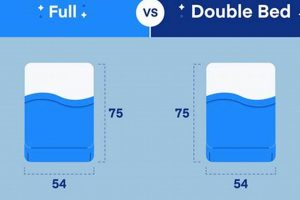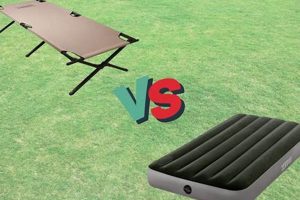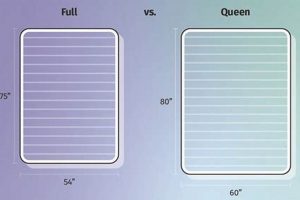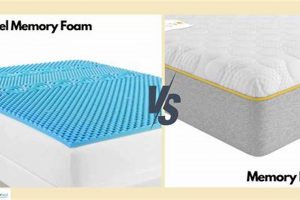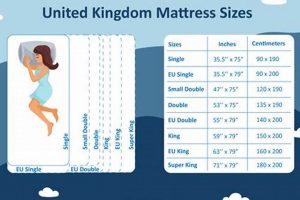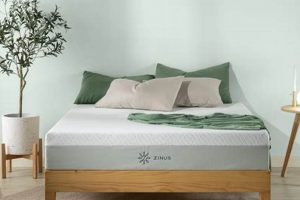A thin layer of padding designed to enhance the comfort and protect the underlying sleeping surface from wear and tear can be differentiated from a thicker, more substantial product intended to significantly alter the feel of the mattress. For example, one might select a quilted layer to safeguard against spills, whereas another might opt for a memory foam addition to improve pressure relief.
The selection between these two options can have implications for the lifespan of the mattress and the quality of sleep experienced. Historically, both have been employed to either extend the usability of an existing mattress or to modify its characteristics to better suit individual preferences. The financial savings realized by improving an existing mattress, versus replacing it, is often a key driver of consumer choice.
Understanding the subtle, yet important, distinctions in construction, purpose, and impact on sleep quality is crucial for informed purchasing decisions. The following sections will delve into these differences, examining materials, thicknesses, and intended applications to provide a clear comparison.
Guidance on Selecting Between Padding and Toppers
The selection process requires careful consideration of individual needs and the current state of the sleeping surface. The following recommendations aim to provide clarity in navigating the available options.
Tip 1: Assess Existing Mattress Condition: Evaluate the condition of the current mattress. If it is new and simply requires protection, a thinner padding may suffice. However, an older mattress with sagging or uneven support may necessitate a substantial topper.
Tip 2: Define Primary Need: Identify the core reason for considering an addition. Is it primarily for spill protection, increased comfort, or targeted pressure relief? Defining this need will narrow the choices considerably.
Tip 3: Material Considerations: Examine the material composition. Cotton and polyester blends offer basic protection, while memory foam and latex provide enhanced comfort and pressure redistribution. Consider potential allergies to materials such as latex.
Tip 4: Thickness Evaluation: Assess the appropriate thickness. Padding is generally thinner, ranging from a fraction of an inch to a few inches. Toppers are typically thicker, often exceeding three inches, to significantly alter the feel of the mattress.
Tip 5: Budgetary Constraints: Establish a realistic budget. Padding is typically more affordable than toppers. Investing in a high-quality topper can still be more economical than replacing an entire mattress.
Tip 6: Maintenance Requirements: Inquire about cleaning and maintenance. Some materials are easier to clean than others. Consider whether the product is machine washable or requires professional cleaning.
Tip 7: Warranty and Return Policies: Review the warranty and return policies. This provides recourse if the product does not meet expectations or exhibits premature wear and tear.
Careful evaluation of these factors, including the thickness, materials, and intended use, empowers individuals to make a more informed decision, aligning the chosen product with their specific needs and contributing to improved sleep quality.
The subsequent section will explore the advantages and disadvantages of each, providing a comprehensive understanding of their individual characteristics.
1. Protection
The protective capacity of a mattress enhancement is directly related to its ability to shield the underlying mattress from various forms of damage and contamination. A pad, typically constructed from tightly woven fabrics like cotton or polyester blends, offers a fundamental barrier against spills, dust mites, and general wear and tear. This safeguards the mattress from stains and allergens, potentially extending its lifespan. A common example is the use of a waterproof pad to protect against accidental liquid spills from children or pets, preventing absorption into the mattress core and mitigating potential mold growth.
Toppers, while primarily focused on enhancing comfort, can also provide a degree of protection. Their greater thickness and density offer an additional layer of defense against indentations and uneven wear caused by body weight. However, the effectiveness of a topper as a protective barrier depends heavily on its material composition. While some toppers may incorporate waterproof or hypoallergenic properties, their primary function remains comfort modification. A topper made of open-cell memory foam, for instance, might be less effective at repelling liquids compared to a tightly woven pad treated with a waterproof coating.
The selection between a pad and a topper for protection hinges on the specific risk factors and desired level of defense. If the primary concern is safeguarding against minor spills and allergens, a pad represents a cost-effective solution. However, if the goal is to prevent indentations and uneven wear, while also improving comfort, a topper may be more suitable. Ultimately, understanding the inherent protective capabilities of each option allows for a targeted approach, optimizing the investment in mattress preservation.
2. Comfort
The subjective experience of comfort is a primary differentiator between these sleep surface enhancements. A pad typically provides a subtle alteration to the existing mattress feel, offering a slight cushioning effect without significantly changing the underlying support structure. This is attributable to its thinner profile and less dense construction. For instance, a person satisfied with the firmness of their current mattress, but desiring a slightly softer surface feel, might select a quilted mattress pad. The effect would be akin to adding a thin layer of padding, minimally impacting the original support characteristics.
Conversely, a topper is designed to substantially modify the comfort level of the mattress. Its greater thickness and varying material compositions, such as memory foam or latex, allow for a more pronounced alteration in feel and support. Someone experiencing pressure points or discomfort on a firm mattress might opt for a memory foam topper to contour to the body and redistribute weight, mitigating these issues. The resulting effect is a significant change in the overall sleep experience, potentially transforming a firm mattress into one offering a softer, more cradling sensation. The type of foam and its density will contribute to the comfort, in real-life applications.
In conclusion, the selection must carefully weigh the desired degree of comfort modification. A slight enhancement aligns with a pad, while a substantial change necessitates a topper. Understanding the cause-and-effect relationship between thickness, material, and perceived comfort is crucial. Failure to adequately assess these factors can result in a purchase that fails to meet individual needs, underscoring the practical significance of informed decision-making in selecting a sleep surface enhancement.
3. Thickness
Thickness represents a critical determinant in differentiating a mattress pad from a topper, directly influencing both the perceived comfort and level of support modification. The relatively minimal thickness of a pad, typically ranging from a fraction of an inch to a few inches, results in a subtle alteration to the existing mattress feel. For example, a quilted pad adds a thin layer of cushioning primarily for protection, offering minimal impact on the original mattress support. The causal relationship between this limited thickness and the resulting minimal change underscores the pad’s primary function as a protective layer rather than a significant comfort enhancer. Therefore, assessing a sleep surface enhancement’s dimension is practically significant.
Conversely, a topper, characterized by its greater thickness, often exceeding three inches, provides a substantial modification to the mattress’s feel and support characteristics. The additional material allows for a more pronounced contouring effect, particularly in materials like memory foam or latex. For instance, a four-inch memory foam topper can significantly soften a firm mattress, redistributing pressure points and creating a more cradling sleep surface. This altered characteristic demonstrates that the increased depth can alter the sleeper experience.
Ultimately, understanding the correlation between thickness and functionality is essential for informed purchasing. A thinner pad fulfills a primarily protective role, while a thicker topper serves to modify the existing support and comfort properties of the mattress. The selection must align with the desired level of change and the specific needs of the user, acknowledging that thickness is a key indicator of the product’s intended purpose and subsequent impact on sleep quality.
4. Support
Support, in the context of sleep surfaces, refers to the ability to maintain spinal alignment and distribute body weight evenly, minimizing pressure points and promoting comfortable rest. The capacity to offer adequate support distinguishes the fundamental roles of a mattress pad from a mattress topper. A pad generally provides minimal support enhancement. Its thin construction primarily serves to protect the mattress and add a slight layer of cushioning, rather than significantly altering the existing support characteristics. For instance, placing a thin, quilted cotton pad on a mattress primarily addresses hygiene and surface comfort, not structural support. The existing mattress remains the primary source of support. The use of a pad alone often does not address support-related discomfort.
A topper, conversely, is designed to modify the support characteristics of the underlying mattress. Materials like memory foam and latex, utilized in thicker topper constructions, conform to the body’s contours, distributing weight and reducing pressure on specific areas. Individuals experiencing pressure points in the shoulders or hips may find relief with a memory foam topper, as it redistributes weight and enhances support in those areas. This redistribution can improve spinal alignment and alleviate discomfort. However, the extent of support provided by a topper depends on its material, thickness, and density. A low-density foam topper may compress quickly, offering inadequate long-term support.
Therefore, selecting the appropriate product requires careful assessment of the existing mattress’s support capabilities and individual support needs. If the mattress provides adequate support but requires protection or slight cushioning, a pad may suffice. However, if the mattress lacks sufficient support, or if specific pressure points require targeted relief, a topper is a more appropriate choice. The choice relies on individual needs and mattress capabilities. Neglecting the support component risks selecting a product that fails to address the user’s primary concerns, potentially leading to continued discomfort and disrupted sleep.
5. Durability
Durability, defined as the lifespan and resistance to wear and tear, represents a crucial consideration when evaluating a mattress pad versus a mattress topper. The expected lifespan of either product directly influences its overall value proposition. A mattress pad, typically constructed from less dense materials, prioritizes protection over longevity. Frequent washing and exposure to body weight contribute to a faster degradation of its structure. For example, a thin polyester pad may exhibit pilling and thinning after a year of regular use and laundering, diminishing its protective capabilities. The cause-and-effect relationship between material composition and wear underscores the importance of considering long-term performance.
Mattress toppers, utilizing denser materials like memory foam or latex, often exhibit greater durability. However, the quality and density of these materials are critical factors. A high-density memory foam topper is more resistant to compression and maintains its shape for a longer period compared to a lower-density alternative. The effect is a more consistent level of comfort and support over time. Furthermore, the care provided significantly impacts longevity; using a protective cover and following cleaning instructions extends the lifespan. Regular rotation, if recommended, aids in even wear distribution.
Ultimately, the expected lifespan must be factored into the purchase decision. While a mattress pad offers an economical solution for short-term protection, a higher-quality mattress topper represents a longer-term investment in comfort and support. The understanding of these durability differences enables consumers to align their selection with their budget, anticipated usage, and long-term needs, thereby maximizing the value derived from their purchase. Selecting a product with a shorter expected lifespan may lead to more frequent replacements, negating the initial cost savings.
6. Cost
The financial investment associated with sleep surface enhancements forms a significant element in the decision-making process. Mattress pads typically represent a more economical option, reflecting their simpler construction and less substantial material usage. For instance, a basic quilted mattress pad designed for spill protection may retail for a fraction of the price of a specialized memory foam topper. The cause is directly linked to materials, manufacturing, and features involved. The importance of cost considerations lies in aligning the purchase with budgetary constraints and long-term value expectations. Budget-conscious consumers frequently prioritize functionality and protection over extensive comfort modifications.
Mattress toppers, while offering enhanced comfort and support, command a higher price point. This reflects the increased material density, specialized construction techniques, and potential inclusion of advanced features, such as cooling technology or zoned support. Purchasing a topper featuring premium materials, such as certified organic latex or high-density memory foam, involves a considerably larger financial outlay than selecting a standard pad. Practical applications include considering the long-term costs: a topper, despite a higher initial investment, may delay the need for a new mattress, potentially offsetting its higher price.
Ultimately, the optimal choice balances cost with performance and longevity. While a mattress pad provides a budget-friendly solution for basic protection, a topper represents a more substantial investment in sleep quality and support. The understanding of the cost implications, in conjunction with individual needs and long-term expectations, enables informed decision-making and ensures the selected product aligns with both financial limitations and desired sleep outcomes. The initial savings of a pad can be offset by the cost of replacing a degraded mattress sooner than anticipated.
Frequently Asked Questions
The following section addresses common inquiries regarding the distinctions and appropriate applications of sleep surface enhancements.
Question 1: Is a mattress pad or topper more effective at extending the life of a mattress?
Both offer a degree of protection. However, a topper, due to its greater thickness and density, can provide more substantial protection against wear and tear, potentially prolonging the mattress’s lifespan more effectively.
Question 2: Can either option correct a sagging mattress?
A pad offers negligible improvement in correcting a sagging mattress. A topper, particularly one made of dense foam, may provide temporary relief by creating a more uniform sleep surface, but it is not a permanent solution for significant sagging.
Question 3: Are mattress pads and toppers suitable for all types of mattresses?
Both are generally compatible with most standard mattress types. However, certain considerations apply. For example, using a thick topper on a very soft mattress could exacerbate sinking and discomfort. Conversely, using a pad without water proofing might ruin the warranty.
Question 4: How does cleaning differ between mattress pads and toppers?
Mattress pads are often machine washable, while toppers typically require spot cleaning or professional cleaning due to their size and material composition. Refer to the manufacturer’s instructions for specific cleaning recommendations.
Question 5: Can a topper or pad alleviate back pain?
While individual experiences vary, a topper, particularly one made of memory foam or latex, may provide pressure relief and improved spinal alignment, potentially reducing back pain. A pad offers minimal impact on back pain.
Question 6: Are there hypoallergenic options available for both?
Yes, both pads and toppers are available in hypoallergenic materials. Look for options made from materials like hypoallergenic cotton, bamboo, or latex to minimize allergen exposure.
In summary, while both enhance sleep surfaces, understanding their limitations and benefits allows for more informed decisions.
The subsequent section will provide a comparative table to illustrate the differences between pads and toppers.
mattress pad vs mattress topper
This exploration of the distinction between mattress pad vs mattress topper has highlighted key differentiating factors. The choice between the two hinges on individual needs, existing mattress condition, and desired level of comfort modification. Mattress pads primarily serve protective functions, while mattress toppers offer more substantial alterations to support and comfort.
The informed selection of either a mattress pad vs mattress topper necessitates a thorough assessment of material composition, thickness, durability, and cost. By considering these factors, consumers can optimize their sleep environment and enhance the longevity of their mattress investment. The ultimate decision should align with specific needs and priorities, contributing to improved sleep quality and overall well-being.


